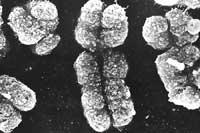Advances in stem cell research
The results of stem cell research are often disappointing: after awakening great hope, beliefs are often corrupt. On other occasions, however, they open up new avenues, such as research that has shown that brain stem cells are ‘invisible’ to the immune system.
To demonstrate this, researchers at Harvard University have introduced stem cells extracted from the brain of mice into the retina of other mice and have not given them medicine to prevent rejection. Normally, when cells from another are introduced or introduced into one body, the immune system considers them strange and removes them.

This is the main problem of transplants. However, these mice introduced by brain stem cells have not had any problems, but they have developed correctly. Therefore, research has opened the way to solve some vision problems.
Another study reveals that a substance found in frog eggs helps reprogram human cells. To obtain stem cells from adult human cells, researchers at the University of Cambridge have introduced into Xenopus eggs the white blood cell nuclei of human blood and mice.
Two days later, they detected in these eggs a molecule, RNA Oct4, which characterizes stem cells. Therefore, researchers conclude that adult nuclei have begun to resemble stem cells. However, they report that this is another step in understanding the reprogramming and solving the problems that arise in this process.





